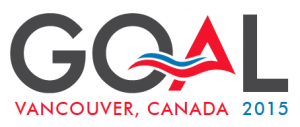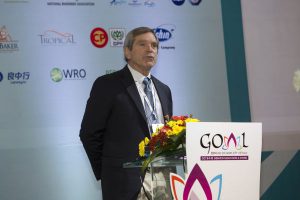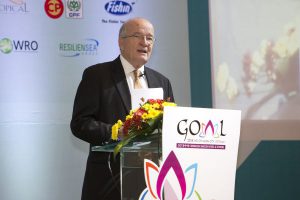GOAL 2014 Roundup: Speakers Address Array Of Issues
 With a successful GOAL 2014 in the rearview mirror, the Global Aquaculture Alliance is gearing up for a productive GOAL 2015 in Vancouver, Canada— the first time in six years that the GOAL conference is being held in North America and the first time ever that it’s being held in Canada.
With a successful GOAL 2014 in the rearview mirror, the Global Aquaculture Alliance is gearing up for a productive GOAL 2015 in Vancouver, Canada— the first time in six years that the GOAL conference is being held in North America and the first time ever that it’s being held in Canada.
(Click here to visit the GOAL 2015 home page. The dates and venue of GOAL 2015 will be announced in November, and registration will open soon thereafter.)
This year’s conference program featured 50-plus speakers and more than 425 attendees.
As usual, attendees spanned the seafood supply chain. According to the conference’s automatic response system, buyers represented slightly more than 40% of attendees, followed by producers at 13%, suppliers at 8%, government/institution at 6% and “other” (finance, academics, NGO) at 32%.
The four-day conference program reflected the diversity of attendees, with an array of topics relevant to all. The major topics addressed at GOAL 2014 were animal health and welfare (particularly disease management and early morality syndrome in shrimp), zone management, aquafeed sustainability, smallholder engagement and marketplace accessibility, food safety, and aquaculture insurance and risk management. Also, individual presentations touched on China’s marketplace, the aquaculture landscapes of Indonesia and Vietnam, and engagement of the investment community.
(Unable to attend GOAL 2014? Access to synchronized video and slide presentations from GOAL 2014—featuring around 20 hours of presentations and panel discussions and more than 50 speakers—will be available for purchase soon. Questions? Contact GAA Communications Manager Steven Hedlund at steven.hedlund@gaalliance.org.)
Next year’s conference program is already in development. At least four themes will likely carry over from Vietnam to Canada. Health and disease management is a fixture of the Day 1 program, and GOAL 2015 will be no exception. At GOAL 2014, GAA President George Chamberlain was the bearer of good news and bad news. “The battle against early mortality syndrome is shifting from guessing what to do to implementing what works,” he said. However, new diseases are already appearing in shrimp in Asia – diseases that will surely be explored at GOAL 2015.
(Chamberlain pictured at right. Courtesy of Gail Hannagan of Preferred Freezer Services.)
Zone management is also shaping up to be a theme of GOAL 2015. Zone management—a key to effective disease management—created a buzz at GOAL 2014. Peter Marshall of R.S. Standards, who chairs the Best Aquaculture Practices Zone Management Technical Committee, expressed that zone management can be a vehicle by which to move small-scale farmers closer to third-party certification and help attract investment.
Aquafeed is sure to return as a theme at GOAL 2015. An entire day of the GOAL 2014 program was dedicated to aquafeed sustainability. The seminar —which featured 16 speakers and a robust question-and-answer session – drew more than 150 attendees and centered on the environmental and social concerns related to aquafeed production. GOAL 2015 will offer an update on the work being done to improve the social components and other aspects of reduction and by-catch fisheries.
Finally, the need to better involve small-scale farmers in the sustainable seafood movement is destined to carry into GOAL 2015, given the attention it garnered at GOAL 2014. GAA and others are advocating a stepped approach to smallholder engagement, because the majority of small-scale farmers are not ready to pursue third-party certification. GOAL 2015 will offer an update on initiatives to engage smallholders.
Other themes will be relatively new next year, particularly consumer education. At GOAL 2014, GAA Executive Director Wally Stevens added consumer education as the seventh major challenge facing aquaculture.
(Stevens pictured at left. Courtesy of Gail Hannagan of Preferred Freezer Services.)
Vancouver is an ideal place to dive into the topic. It is an environmentally conscious city with sophisticated seafood consumers. It is also a breeding ground for aquaculture misinformation, so GOAL 2015 presents an opportunity to set the record straight.
Given its prevalence on Canada’s west coast, salmon aquaculture will also be prominent next year. Canada’s salmon aquaculture leaders—and those from other salmon-farming countries like Chile—are being invited to speak at GOAL 2015 about leadership and the future of their industry.





